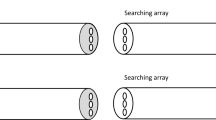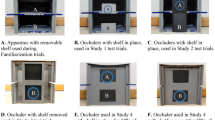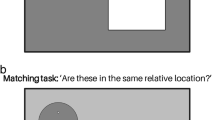Abstract
We investigated reasoning about spatial relational similarity in three great ape species: chimpanzees, bonobos, and orangutans. Apes were presented with three spatial mapping tasks in which they were required to find a reward in an array of three cups, after observing a reward being hidden in a different array of three cups. To obtain a food reward, apes needed to choose the cup that was in the same relative position (i.e., on the left) as the baited cup in the other array. The three tasks differed in the constellation of the two arrays. In Experiment 1, the arrays were placed next to each other, forming a line. In Experiment 2, the positioning of the two arrays varied each trial, being placed either one behind the other in two rows, or next to each other, forming a line. Finally, in Experiment 3, the two arrays were always positioned one behind the other in two rows, but misaligned. Results suggested that apes compared the two arrays and recognized that they were similar in some way. However, we believe that instead of mapping the left–left, middle–middle, and right–right cups from each array, they mapped the cups that shared the most similar relations to nearby landmarks (table’s visual boundaries).




Similar content being viewed by others
References
Barth J, Call J (2006) Tracking the displacement of objects: a series of tasks with great apes (Pan troglodytes, Pan paniscus, Gorilla gorilla, and Pongo pygmaeus) and Young Children (Homo sapiens). J Exp Psychol Anim Behav Process 32:239–252
Bovet D, Vauclair J (2001) Judgment of conceptual identity in monkeys. Psychon Bull Rev 8:470–475
Call J (2001) Object permanence in Orangutans (Pongo pygmaeus), Chimpanzees (Pan troglodytes), and Children (Homo sapiens). J Comp Psychol 115:159–171
Chen Z (2007) Learning to map: strategy discovery and strategy change in young children. Dev Psychol 43:386–403
Christie S, Gentner D (2007) Relational similarity in identity relation: the role of language. In: Vosniadou S, Kayser D, Protopapas A (eds) Proceedings of the second European cognitive science conference. Taylor & Francis, London
Cook RG, Wasserman EA (2007) Learning and transfer of relational matching-to-sample by pigeons. Psychon Bull Rev 14:1107–1114
de Blois ST, Novak MA, Bond M (1998) Object permanence in Orangutans (Pongo pygmaeus) and squirrel monkeys (Saimiri sciureus). J Comp Psychol 112:137–152
Deipolyi A, Santos L, Hauser MD (2001) The role of landmarks in cotton-top tamarin spatial foraging: evidence for geometric and non-geometric features. Anim Cogn 4:99–108
DeLoache JS (2004) Becoming symbol-minded. Trends Cogn Sci 8:66–70
DeLoache JS, Brown AL (1983) Very young children’s memory for the location of objects in a large-scale environment. Child Dev 54:888–897
DeLoache JS, de Mendoza OAP, Anderson KN (1999) Multiple factors in early symbol use: instructions, similarity, and age in understanding a symbol-referent relation. Cogn Dev 14:299–312
Dépy D, Fagot J, Vauclair J (1999) Processing of above: below categorical spatial relations by baboons (Papio papio). Behav Process 48:1–9
Diedrichsen J, Werner S, Schmidt T, Trommershäuser J (2004) Immediate spatial distortions of pointing movements induced by visual landmarks. Percept Psychophys 66:89–103
Dolins FL (2009) Captive cotton-top tamarins’ (Saguinus oedipus oedipus) use of landmarks to localize hidden food items. Am J Primatol 71:316–323
Fagot J, Parron C (2010) Relational matching in baboons (Papio papio) with reduced grouping requirements. J Exp Psychol Anim Behav Process 36:184–193
Fagot J, Wasserman EA, Young ME (2001) Discriminating the relation between relations: the role of entropy in abstract conceptualization by baboons (Papio papio) and humans (Homo sapiens). J Exp Psychol Anim Behav Process 27:316–328
Flemming TM, Beran MJ, Washburn DA (2007) Disconnect in concept learning by rhesus monkeys (Macaca mulatta): judgment of relations and relations-between-relations. J Exp Psychol Anim Behav Process 33:55–63
Flemming TM, Beran MJ, Thompson RKR, Kleider HM, Washburn DA (2008) What meaning means for same and different: analogical reasoning in humans (Homo sapiens), chimpanzees (Pan troglodytes), and rhesus monkeys (Macaca mulatta). J Comp Psychol 122:176–185
Gentner D (2003) Why we’re so smart. In: Gentner D, Goldin-Meadow S (eds) Language in mind: advances in the study of language and thought. The MIT Press, Cambridge, pp 195–235
Goswami U (1991) Analogical reasoning: what develops? a review of research and theory. Child Dev 62:1–22
Goswami U (1995) Transitive relational mappings in three- and four-year-olds: the analogy of goldilocks and the three bears. Child Dev 66:877–892
Goswami U, Brown AL (1990) Melting chocolate and melting snowmen: analogical reasoning and causal relations. Cognition 35:69–95
Halford GS, Wilson WH, Phillips S (1998) Processing capacity defined by relational complexity: implications for comparative, developmental, and cognitive psychology. Behav Brain Sci 21:803–831
Haun DBM, Call J (2009) Great apes’ capacities to recognize relational similarity. Cognition 110:147–159
Herrmann E, Call J, Hernández-Lloreda MV, Hare B, Tomasello M (2007) Humans have evolved specialized skills of social cognition: the cultural intelligence hypothesis. Science 317:1360–1366
Hoffman ML, Beran MJ (2006) Chimpanzees (Pan troglodytes) remember the location of a hidden food item after altering their orientation to a spatial array. J Comp Psychol 120:389–393
Holland JH, Holyoak KJ, Nisbett RE, Thagard P (1986) Induction: processes of inference, learning and discovery. Bradford Books/The MIT Press, Cambridge
Holyoak KJ, Junn EN, Billman DO (1984) Development of analogical problem-solving skill. Child Dev 55:2042–2055
Huttenlocher J, Presson CC (1979) The coding and transformation of spatial information. Cogn Psychol 11:375–394
Huttenlocher J, Newcombe N, Sandberg EH (1994) The coding of spatial location in young children. Cogn Psychol 27:115–147
Kennedy EH, Fragaszy DM (2008) Analogical reasoning in a capuchin monkey (Cebus apella). J Comp Psychol 122:167–175
Kroger JK, Holyoak KJ, Hummel JE (2004) Varieties of sameness: the impact of relational complexity on perceptual comparisons. Cogn Sci 28:335–358
Kubo-Kawai N, Kawai N (2007) Interference effects by spatial proximity and age-related declines in spatial memory by Japanese Monkeys (Macaca fuscata): deficits in the combined use of multiple spatial cues. J Comp Psychol 121:189–197
Leech R, Mareschal D, Cooper RP (2008) Analogy as relational priming: a developmental and computational perspective on the origins of a complex cognitive skill. Behav Brain Sci 31:357–378
Loewenstein J, Gentner D (2005) Relational language and the development of relational mapping. Cogn Psychol 50:315–353
MacDonald SE, Spetch ML, Kelly DM, Cheng K (2004) Strategies in landmark use by children, adults, and marmoset monkeys. Learn Motiv 35:322–347
Menzel CR (1996) Spontaneous use of matching visual cues during foraging by long-tailed macaques (Macaca fascicularis). J Comp Psychol 110:370–376
Penn DC, Holyoak KJ, Povinelli DJ (2008) Darwin’s mistake: explaining the discontinuity between human and nonhuman minds. Behav Brain Sci 31:109–130
Pepperberg IM (1987) Acquisition of the same/different concept by an African grey parrot (Psittacus erithacus): learning with respect to categories of color, shape and material. Anim Learn Behav 15:423–432
Potì P, Bartolommei P, Saporiti M (2005) Landmark use by Cebus apella. Int J Primatol 26:921–948
Potì P, Kanngiesser P, Saporiti M, Amiconi A, Bläsing B, Call J (2010) Searching in the Middle–Capuchins’ (Cebus apella) and Bonobos’ (Pan paniscus) behavior during a spatial search task. J Exp Psychol Anim Behav Process 36:92–109
Quinn PC, Adams A, Kennedy E, Shettler L, Wasnik A (2003) Development of an abstract category representation for the spatial relation between in 6- to 10-month-old infants. Dev Psychol 39:151–163
Ramscar MJA, Pain HG (1996) Can a real distinction be made between cognitive theories of analogy and categorization? In: Proceedings of the 18th annual conference of the cognitive science society, University of California, San Diego, pp 346–351
Rattermann MJ, Gentner D (1998) The effect of language on similarity: the use of relational labels improves young children’s performance in a mapping task. In: Holyoak KJ, Gentner D, Kokinov B (eds) Advances in analogy research: integration of theory and data from the cognitive, computational and neural sciences. New Bulgarian University, Sophia, pp 274–282
Richland LE, Morrison RG, Holyoak KJ (2006) Children’s development of analogical reasoning: insights from scene analogy problems. J Exp Child Psychol 94:249–273
Simms N, Gentner D (2008) Spatial language and landmark use: can 3-, 4-, and 5-year-olds find the middle? In: Love BC, McRae K, Sloutsky VM (eds) Proceedings of the 30th annual conference of the cognitive science society. Cognitive Science Society, Austin, pp 191–196
Spencer JP, Hund AM (2003) Developmental continuity in the processes that underlie spatial recall. Cognit Psychol 47:432–480
Spencer JP, Smith LB, Thelen E (2001) Tests of a dynamic systems account of the a-not-b error: the influence of prior experience on the spatial memory abilities of two-year-olds. Child Dev 72:1327–1346
Spinozzi G, Lubrano G, Truppa V (2004) Categorization of above and below spatial relations by tufted capuchin monkeys (Cebus apella). J Comp Psychol 118:403–412
Sutton JE, Olthof A, Roberts WA (2000) Landmark use by squirrel monkeys (Saimiri sciureus). Anim Learn Behav 28:28–42
Thibaut J-P, French R, Vezneva M (2008) Analogy-making in children: the importance of processing constraints, 30th annual meeting of the cognitive science society, Washington, DC
Thompson RKR, Oden DL, Boysen ST (1997) Language-naive chimpanzees (Pan troglodytes) judge relations between relations in a conceptual matching-to-sample task. J Exp Psychol Anim Behav Process 23:31–43
Tomasello M (2003) Constructing a language: a usage-based theory of language acquisition. Harvard University Press, Cambridge
Uttal DH, Sandstrom LB, Newcombe NS (2006) One hidden object, two spatial codes: young children’s use of relational and vector coding. J Cogn Dev 7:503–525
Vonk J (2003) Gorilla (Gorilla gorilla gorilla) and Orangutan (Pongo abelii) understanding of first- and second-order relations. Anim Cogn 6:77–86
Wright AA, Katz JS (2006) Mechanisms of same/different concept learning in primates and avians. Behav Process 72:234–254
Acknowledgments
This study was supported by the German Academic Exchange Service (DAAD) through a grant to the first author. We thank James Close for providing helpful comments on an earlier version of the manuscript as well as for improving the English of the manuscript. The reported experiments comply with all laws of the country in which they were performed.
Author information
Authors and Affiliations
Corresponding author
Rights and permissions
About this article
Cite this article
Hribar, A., Haun, D. & Call, J. Great apes’ strategies to map spatial relations. Anim Cogn 14, 511–523 (2011). https://doi.org/10.1007/s10071-011-0385-6
Received:
Revised:
Accepted:
Published:
Issue Date:
DOI: https://doi.org/10.1007/s10071-011-0385-6




